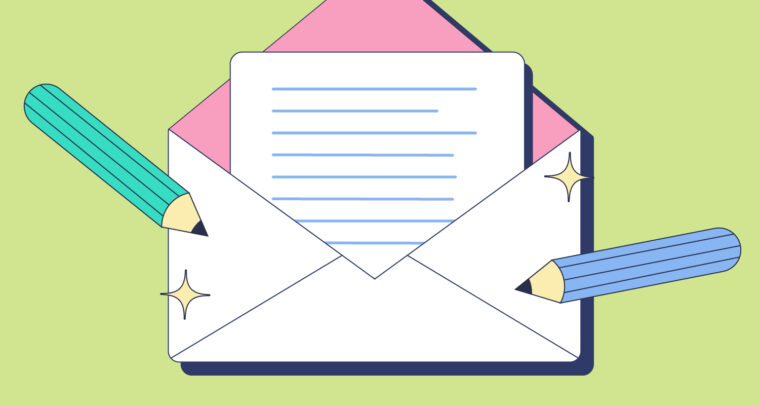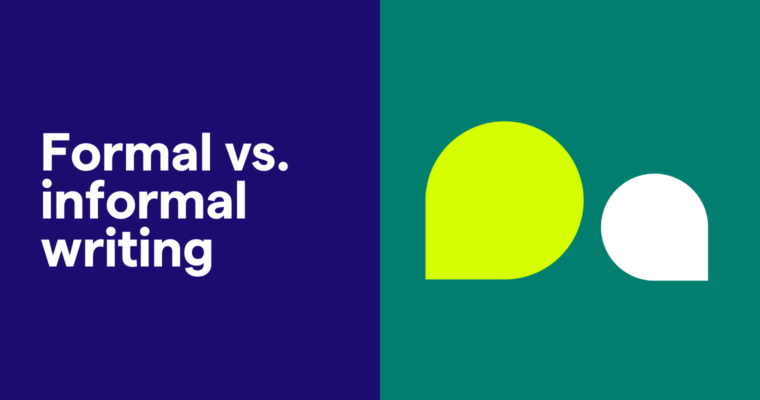
Everyone should know how to write a letter, whether a business inquiry, email, personal letter, or letter-format social media post. Letter writing is a useful skill, not only for communicating clearly, but also for making a good impression—especially a first impression.
Below we explain how to write a proper letter, no matter the type you need. We’ll cover the correct format for a formal letter, such as a cover letter or job inquiry, as well as tips for writing a personal letter, with some helpful examples of each.
How to write a letter
Here are some quick steps for how to write a letter:
- Choose your format (email, paper and mail, etc.)
- Write your contact information and date at the top if you’re using block style (see below).
- On a new line write a salutation, such as “Dear Ms. Smith,” or “To Whom It May Concern.”
- Write the body of your letter in a standard paragraph format.
- On a new line write a complimentary close, such as “Sincerely,” or “Best,”
- Sign your name under the complimentary close.
What type of letter should you write?
There are no hard-and-fast rules. The most suitable letter format depends on your audience. For a friend or close relative, a casual message or informal letter is usually the best way to go. There are different types of letters that are appropriate for this format. Some include:
- Handwritten letters
- Emailed letters
- Typed social media messages
However, for business contacts or people you don’t know well, a typed formal letter is almost always the most appropriate choice. When used for professional purposes, writing a formal letter is effective for the following:
- Cover letters
- Letters of intent
- Value proposition letters
- Business memorandum letters
- Promotion letters
- Reference letters
- Resignation letters
- Thank you letters
These are just some of the types of letters that you might need to write in a casual or professional environment. Before writing a letter, consider the type of letter you need: formal or informal. Each has a distinct format you’ll want to follow.
Formal letter writing: block style vs. AMS style
Formal letters—like cover letters, business inquiries, and urgent notifications— are some of the most important letters you’ll ever have to write. Because they’re sometimes used as official documents, formal letters have a very precise structure and particular format. In fact, there are a few different “correct formats” to choose from.
The most common formats for formal letter writing are block style and American Mathematical Society, or AMS, style. In the example below, we use block style, specifically full block style, because it’s the most popular. Block style is characterized by all elements being aligned on the left margin of the page. This includes the first lines of paragraphs, which don’t use indentation.
AMS is fairly similar, following many of the same rules as block style. There are a few differences, however, which we briefly cover after the next section.
How to write a formal letter in block style
Step 1: Write the contact information and date
All formal letters start with the contact information and date. In the full block style, this goes in the upper left-hand corner.
First, as the sender, type your full name and address aligned to the left side, just as you would when addressing an envelope. This isn’t just a formality, but a useful inclusion so the recipient can easily find your contact information when they want to respond.
If you’re writing on official company letterhead that already includes this information, you do not need to rewrite the contact information.
After your address, skip a line and then add the date you’re writing the letter.
Last, skip a line again and add the recipient’s name and full address. Feel free to include their job title below their name if it’s relevant. Leave a blank line after the contact information before writing the salutation.
Step 2: Write the salutation
Formal letters always have a greeting at the beginning of the written content as a cue that your message is about to begin. This is known as the salutation.
Most salutations begin with “Dear” and then the name of the recipient. All salutations use title capitalization and end in a comma.
If you don’t know the name of the receiver, you can also use a job title or even the department name, for example, “Dear HR Representative.” As a last resort, you can use the generic salutation “To Whom It May Concern” in any circumstance. Try to avoid “Dear Sir or Madam,” as it’s a little outdated.
Step 3: Write the body of the letter
This is where you write your message. The body of the letter follows the normal rules of grammar, so write it as you would any other formal document. The one exception for full block style is that you do not indent the first lines of paragraphs.
Unlike personal letters, formal letters are straightforward and direct, so don’t be afraid to get straight to the point. Some formal letters are only a sentence or two long, although others can go on for paragraphs if there’s a lot of information to convey. The important thing is that you stay focused and avoid tangential topics.
Although different company cultures have different communication standards, it’s a safe bet to avoid casual phrasing and jokes; some even advise against using contractions. It should go without saying, but don’t use slang, profanity, or other inappropriate language.
If your letter covers a lot, it’s best to include a closing paragraph at the end to summarize everything the recipient needs to know. As always, don’t forget to edit and proofread the body of the letter before sending.
Step 4: Write the complimentary close
Formal letters also use a standard complimentary close or sign-off, similar to the salutation, before ending with an authentic signature.
One of the most common closers is “Sincerely,” including some variations like, “With sincere gratitude,” or “Sincerely yours.” Other common sign-offs include “Best,” and “Yours.” Unlike salutations, closers use sentence capitalization. Always capitalize the first letter of your complimentary close, but only the first letter. And just like the salutation, always end with a comma.
If you’re sending a paper letter, skip a few lines after your complimentary close—this is where you sign your name. Additionally, always type your name below the signature, along with your job title if relevant. When sending an email or other digital letter, you don’t have to leave a blank line before you type your full name.
Step 5: Mention enclosed materials
This last step is necessary only if you’re sending additional materials with the letter, such as a résumé or CV, application, voucher, etc. If you’re sending only the letter, disregard this step.
After your printed name and optional job title (under your signature), skip a line and then write “Enclosure:” followed by a list of the materials you’ve included. For example, if you were including a résumé, you would write “Enclosure: Résumé.” This is simply a precaution so the recipient doesn’t miss anything or, if they need to, can verify that something was lost in shipping.
Formal letter example (block style)
Detective Inspector G. Lestrade
35 Victoria Embankment
London, England SW1A 2JL, UK
July 1, 1888
Mr. Sherlock Holmes
221B Baker St.
London, England NW1 6XE, UK
Dear Mr. Holmes,
On behalf of the London police force, we request your presence at New Scotland Yard at your earliest convenience. We have a case that requires your special expertise, and we’d prefer to discuss the details in person, considering the sensitivity of the information. Any time before the end of the month is acceptable.
Sincerely,
G. Lestrade
Detective Inspector
Enclosure: Visitor pass
How to write a formal letter in AMS style
For the most part, AMS style uses the same rules and guidelines as block style, including enclosures, so you can follow the steps above regardless of the style you use. However, there are two major differences in AMS style that you need to be aware of:
- Don’t leave a blank line between the sender’s full address and the date. The date comes directly underneath the address.
- AMS style always uses a subject line in place of or before the salutation. The subject line should be written in all caps and summarize the content of the letter in no more than a single line, such as “YOUR PRESENCE IS REQUESTED AT SCOTLAND YARD.” As with salutations, leave a blank line before and after the subject line.
Formal letter example (AMS style)
Detective Inspector G. Lestrade
35 Victoria Embankment
London, England SW1A 2JL, UK
July 1, 1888
YOUR PRESENCE IS REQUESTED AT SCOTLAND YARD
Dear Mr. Holmes,
[. . .]
How to write an informal letter
True to their name, informal letters are a lot more casual than formal letters. That means there aren’t nearly as many rules and guidelines, and no one will mind if you don’t leave a blank space in the right spot.
Still, there is a correct format that people are familiar with, so follow the steps below as a bare minimum.
Step 1: Put the date at the top (optional)
Putting the date at the top of a letter is a custom stemming from a time when letter writing was the primary means of communication. Nowadays, including the date is no longer a necessity, but some people still do it because of tradition. In informal letters, it’s completely optional.
Step 2: Write the salutation
Just like formal letters, informal letters start with a polite greeting to the recipient. The standard format is the same: the word “Dear” followed by the person’s name, as in “Dear Mr. Lestrade,” using title capitalization.
However, informal letters provide more freedom when it comes to what you say in your greeting, and it’s not uncommon to see casual greetings like, “Hi [Name],” or “Hello [Name].”
As with salutations in formal letters, you normally end your greeting with a comma and then skip a line before beginning the body of the letter. Occasionally you see people end the salutation with an exclamation point, depending on their relationship with the recipient.
Step 3: Write the body of the letter
The body of the letter is where you write your message, and informal letters are often meant to share news or keep in touch. They tend to have a conversational tone, which means you’re free to include slang and whatever language you use when speaking in person.
While tangents are more permissible in informal letters, going off topic excessively can still bother the reader. Try to stay focused as best you can without sounding restrained—informal letters are supposed to be personal, after all.
Step 4: Write the complimentary close
Informal letters also use a complimentary close before the signature, following the same format as formal letters. That includes using sentence capitalization (capitalizing only the first letter), adding a comma at the end, and leaving enough space to sign your name if you’re sending a paper letter.
However, you don’t need to stick with the conventional sign-offs like “Sincerely.” If you’re writing a personal letter, you can use something more sentimental depending on the relationship with the recipient, such as “Love,” “Warm regards,” or “See you soon.”
Informal letter example
July 2, 1888
What’s up, Lestrade!?
It’s Sherlock! So stoked to receive your letter. Of course I’ll come to Scotland Yard ASAP, no worries.
XOXO,
Sherlock “Best Detective Ever” Holmes
What’s PS?
PS stands for postscript. It’s something you add at the last minute after the letter is complete, usually either minor news or something small you forgot when writing the body of the letter. Typically, you don’t use postscripts in formal letters; if you need to add something, you’ll have to revise the whole document to include the new information.
When writing a postscript, simply write the letters “PS” and then your message. It doesn’t matter if you use periods or not (“PS” and “P.S.” are both acceptable), but both letters should always be capitalized.
If you have more than one postscript, simply add another P to the beginning of each new PS. For example, your second postscript should be labeled “PPS.” and your third postscript should be “PPPS.”
PS. Rob got the position at Great Company! Thanks for all the support during his unemployment.
PPS. I have to cancel my birthday party, but we’re still getting together for drinks that night if you want to come.
The envelope
In the United States, the maximum weight for a first-class letter is 3.5 ounces. If your letter is more than three pages or you’ve written it on heavy paper, you’ll have to weigh it to make sure it meets the requirements. The size and shape of the envelope matter too. It has to be rectangular and smaller than roughly 6 by 11 inches, or you run the risk of the post office returning it.
Sending a letter
After you’ve determined that the envelope is the right kind, now you just have to mail it. (If it’s a personal letter, you can always deliver it yourself. In that case, just write the intended recipient’s name on the outside of the envelope. A bonus of hand delivery? You can use any size or shape envelope you want!)
In the top left-hand corner, write your name and address or attach a mailing label. In the center of the envelope, carefully write the name and address of the recipient. Besides the state abbreviation and zip code, international letters should include the country for both the destination and return addresses.
Postage rates vary. Check the US Postal Service website for current prices or use a Forever Stamp for US destinations. Postage goes on the top right-hand corner of the envelope.
Double-check that everything is correct on the outside of the envelope. If it is, fold your letter and insert it neatly. Don’t seal it until you’re sure that you’ve included every page you intend to send.
Letter-writing tips
Still not sure how to write a proper letter? Keep these letter-writing tips in mind to help you communicate with confidence.
Offer pleasantries
While personal letters naturally tend to use a friendly tone, formal letters, too, can benefit from pleasantries and polite etiquette. A simple phrase like “How are you?” or “I hope you’re well” at the beginning of a letter can help connect the sender and recipient, even if the subject matter is strictly business.
Likewise, you can also express sympathy, regret, support, or gratitude in both formal and informal letters. Aside from mere etiquette, these pleasantries establish a personal connection that separates your letters from those written by machines.
Write for your reader
As with all writing, modify your language to accommodate your specific reader. If you’re writing a formal letter to a business associate, be professional and courteous. If you’re writing a personal letter to an old friend, feel free to crack jokes and use slang.
Sometimes the lines blur—a “formal letter” to a work friend might be more casual than a “personal letter” to a distant relative. Keep in mind the specific reader as you write to strike the right tone. If you’ve never met the recipient before, stick to courteous formality.
Include all necessary information
If you have a lot of information to convey, make a small list beforehand to make sure you cover everything. Treat this like a mini-outline to make sure nothing slips through the cracks.
This is especially important for invitations or letters about scheduling events. Make sure you clearly state the essential facts—particularly where and when—as well as other need-to-know information, like directions or special requirements.
Conclusion
Doesn’t it feel good sending a letter you’ve carefully prepared? Certainly, a well-written letter has the best chance of accomplishing its purpose. To make sure your letter really shines, it’s critical that it be mistake-free and set the right tone. Grammarly’s writing assistance catches things like spelling and grammatical mistakes, and Grammarly Premium includes formatting suggestions and guidance that can help you write clear, easy-to-follow letters that hold your recipient’s attention. By using Grammarly, you can write your letter with confidence, wherever you type!
This article was originally written by Jennifer Calonia in 2020. It’s been updated to include new information.





